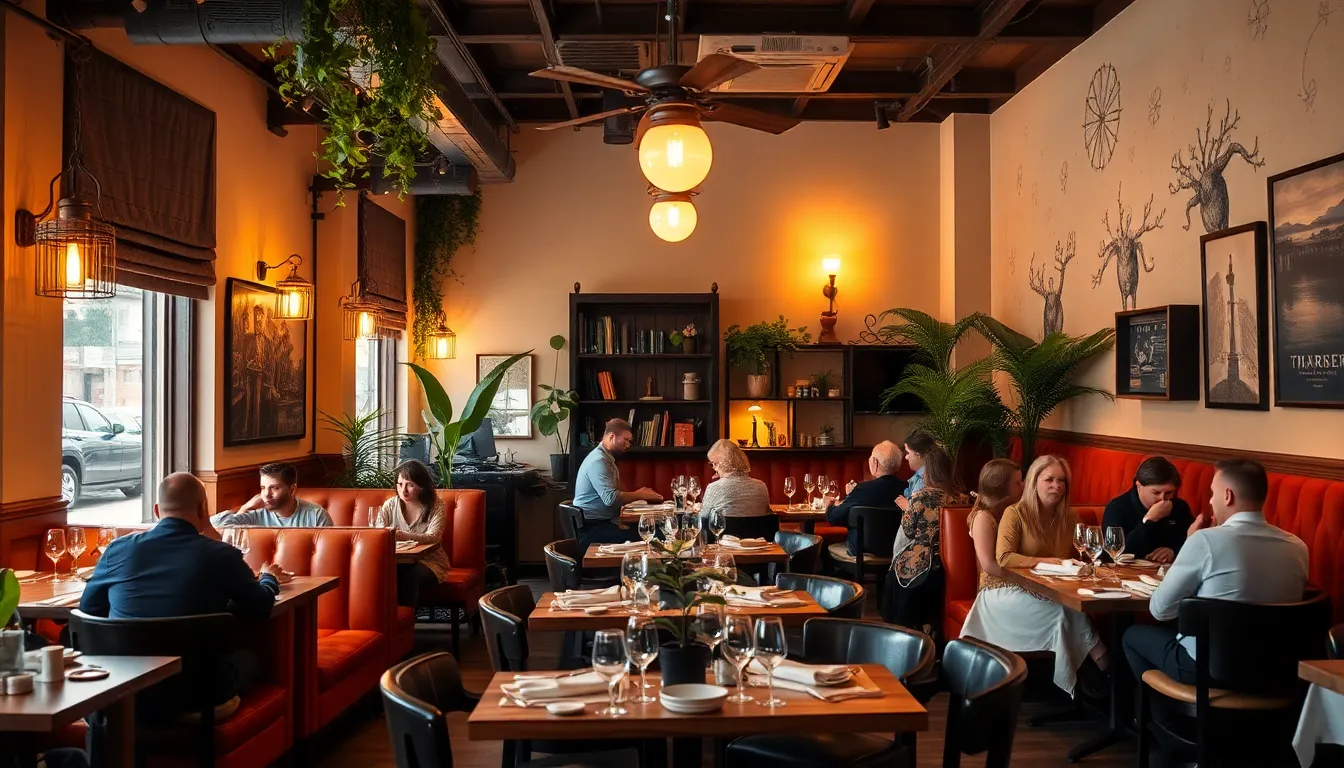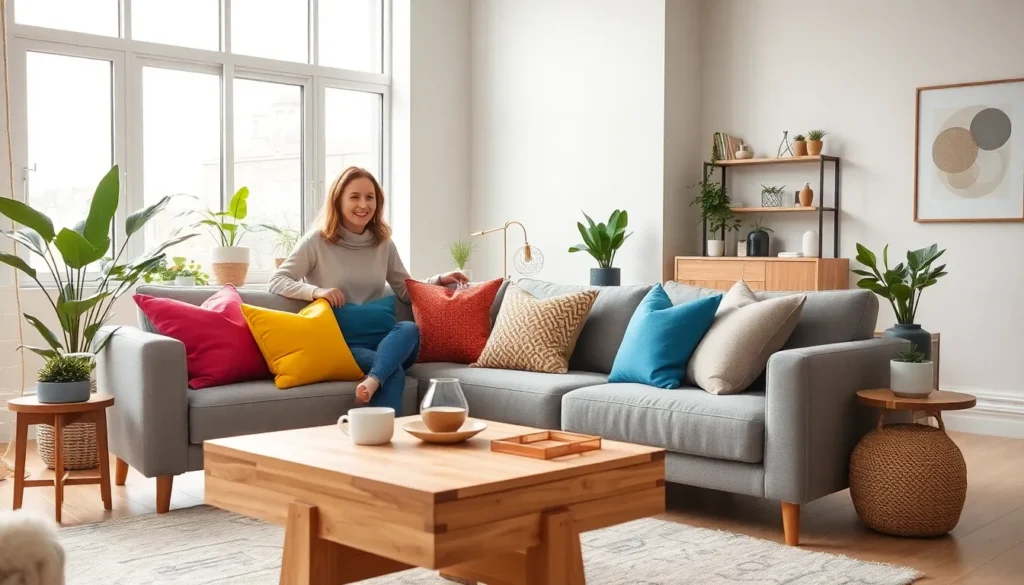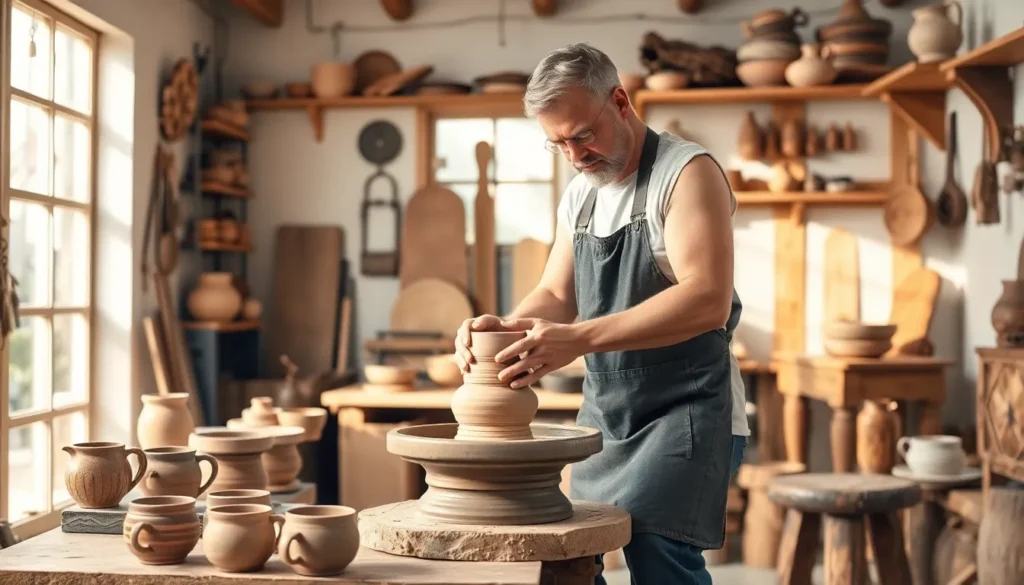When it comes to dining out, the experience goes far beyond just the food. Imagine sinking into a plush booth surrounded by eye-catching decor that sparks joy and conversation. Restaurant design concepts play a pivotal role in creating that unforgettable atmosphere. They set the stage for culinary adventures and social gatherings, transforming a simple meal into a memorable occasion.
Table of Contents
ToggleOverview of Restaurant Design Concepts
Restaurant design concepts encompass various elements that create a unique and inviting atmosphere. The layout significantly influences how patrons interact with the space. Open floor plans promote a communal feeling, while intimate sections encourage private conversations. Incorporating elements like natural light enhances the ambiance, making spaces feel more welcoming.
Color schemes play a crucial role in setting the mood. Warm colors often evoke feelings of comfort, while cooler tones can create a more modern atmosphere. Interior decor items, such as art pieces and plants, contribute to the overall aesthetic, providing visual interest and enhancing the dining experience.
Furniture choices affect both functionality and comfort. Comfortable seating encourages patrons to relax and enjoy their meals, while durable tables withstand regular use. Utilizing different materials, like wood, metal, or fabric, adds texture and depth to the environment.
Lighting design also affects how customers perceive the dining experience. Soft, dim lighting can create a cozy ambiance, while bright lighting might be suitable for casual dining settings. Strategic placement of light fixtures can highlight specific areas of the restaurant, drawing attention to decor or menu items.
Additionally, thematic concepts can enhance the restaurant’s identity. Restaurants that embrace a specific theme, like rustic or modern, create a cohesive experience that resonates with patrons. Consistency in design elements connects different areas, making navigation intuitive for customers.
Incorporating practical considerations within the design maximizes operational efficiency. Well-structured kitchen layouts support a streamlined workflow, ensuring that staff can serve food and drinks promptly. Balancing aesthetic appeal with functionality proves essential to overall success.
Importance of Effective Restaurant Design

Effective restaurant design plays a crucial role in a dining establishment’s success. Ambiance and aesthetics critically influence customer satisfaction and repeat visits.
Enhancing Customer Experience
Creating a comfortable environment enhances customer experience. Spatial layouts encourage easy navigation and foster social interactions. Use of natural light elevates moods and adds warmth. Thoughtful color schemes can stimulate appetite or create relaxation. Additionally, strategic placement of seating influences conversation dynamics, whether inviting communal gatherings or intimate dinners. Elements like themed decor and carefully curated music contribute to a holistic sensory experience.
Influencing Brand Identity
Brand identity is significantly shaped by restaurant design. Visual elements such as logo placement and color choices establish recognition. The theme of a restaurant tells customers about its values and culinary focus. Cohesion in design, from signage to interior decor, strengthens a brand’s message. Unique concepts can differentiate a restaurant in a competitive market. Consistent design reinforces customer expectation, ensuring memorable experiences that promote brand loyalty.
Key Elements of Restaurant Design
Successful restaurant design hinges on several critical components. Each element contributes to the overall dining experience and effectiveness of the establishment.
Layout and Space Planning
Consideration of layout directly impacts patron flow and interaction. An open floor plan promotes social engagement among guests. Conversely, intimate seating arrangements offer privacy for couples and small groups. Strategic placement of dining areas ensures efficient movement for staff and customers alike. Additionally, optimizing space for both functionality and comfort enhances the dining experience. Clear pathways allow for easy navigation, supporting a seamless service flow.
Lighting and Ambiance
Effective lighting design sets the mood within the restaurant. Natural light creates an inviting atmosphere during the day, encouraging customers to linger. In the evening, warm artificial lighting fosters intimacy and relaxation. Variations in lighting can highlight specific decor elements or dining areas, drawing attention where needed. Thoughtful placement of fixtures supports both aesthetic appeal and practicality, enhancing overall functionality. Consistency in lighting contributes to a cohesive experience that resonates with patrons.
Color and Material Selection
Color selection impacts emotional responses and can invoke feelings of comfort. Warmer colors like reds and oranges stimulate appetite, while cool tones like blues and greens promote calmness. Material choices also reflect the restaurant’s theme and identity. For example, rustic wood evokes a cozy feel, while sleek metal surfaces suggest modernity. Combining textures creates visual interest and enhances tactile experiences. Harmonizing colors and materials not only reinforces branding but also elevates overall design coherence.
Innovative Restaurant Design Concepts
Restaurant design evolves continuously to enhance both customer experience and operational efficiency. Innovative concepts focus on sustainability and technology to create modern dining environments.
Sustainable Design Practices
Sustainable design practices in restaurants emphasize eco-friendly materials and energy efficiency. Incorporating reclaimed wood, recycled metals, and low-VOC paints reduces environmental impact. Biophilic design elements like indoor plants improve air quality and create a calming atmosphere. Energy-efficient appliances lower utility costs while benefiting the environment. Using locally sourced food also supports community farmers, promoting sustainability. Establishments adopting these practices attract eco-conscious diners, enhancing brand loyalty through responsible choices.
Technology Integration in Design
Technology integration transforms how diners interact with restaurant spaces. Digital menus on tablets streamline ordering and reduce paper waste. Smart lighting systems adjust intensity based on the time of day, enhancing ambiance. Augmented reality experiences allow customers to visualize dishes before ordering, elevating the dining experience. Contactless payment systems improve service speed and guest convenience. Incorporating wifi enhances customer satisfaction and encourages longer stays, fostering social interaction. These technological advancements keep restaurants competitive in a tech-savvy market.
Trends in Restaurant Design
Recent developments in restaurant design reflect changing consumer preferences and needs. Innovative concepts offer fresh ideas for creating unique dining environments.
Minimalist Design Approach
Minimalist design focuses on simplicity and functionality. Clean lines and uncluttered spaces often characterize this aesthetic. To improve atmosphere, neutral color palettes enhance the feeling of openness. Natural materials such as wood and stone add warmth and texture, making spaces inviting. Essential furniture choices promote comfort without overwhelming patrons. Moreover, strategic lighting emphasizes focal points while maintaining a relaxed ambiance. This approach attracts diners seeking tranquil experiences amid urban chaos.
Open Kitchen Concepts
Open kitchen concepts break down barriers between chefs and diners. Visual transparency enhances engagement by allowing patrons to observe food preparation. This setup fosters trust in the culinary process and highlights the skill of the kitchen staff. Social interactions often increase as guests feel connected to the cooking environment. Additionally, aromas from freshly prepared dishes can elevate the dining experience. An open kitchen also encourages a communal atmosphere, where conversations flow freely. Various design elements support functionality, ensuring a seamless workflow for kitchen operations.
Restaurant design is more than just aesthetics; it’s a crucial factor in shaping memorable dining experiences. By harmonizing elements like layout, lighting, and decor, establishments can create inviting atmospheres that resonate with patrons. Innovative concepts focusing on sustainability and technology are becoming essential in meeting modern consumer demands.
As restaurants continue to evolve, embracing unique design strategies not only enhances customer satisfaction but also strengthens brand identity. A well-thought-out design can differentiate a restaurant in a competitive market, turning a simple meal into a cherished social event. Ultimately, the right design approach can lead to lasting relationships between restaurants and their customers, ensuring ongoing success.









